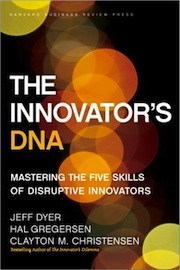How to Spark Student Innovation
A MiddleWeb Blog
Suppose I invited you to watch a class of students who were really engaged in solving a STEM problem. What would you expect to see?
I might expect to see students brainstorming, working hands-on to construct things, talking together with others, and generally looking as if they were enjoying their work. I would also expect the teacher to be supporting and guiding the students. I think that one of the things I would most look for might be evidence of creative ideas and innovative thinking.
Creating an environment that fosters student innovation can be a tall order. It may depend on how collaborative the school culture is, the stress that students might encounter before arriving in your room, and the demands the curriculum and testing make on you as a teacher. Nevertheless, with some deliberate and dedicated effort, you can set the stage for innovative action and learning in your STEM classes.
Read these five innovation sparkers and see if they make sense for you.
1. Create a risk-free, comfortable classroom environment
Cultivate a classroom with a positive atmosphere – one that promotes out-of-the-box and flexible thinking. Keep the stress level low by downplaying competition and promoting cooperation and collaboration. To be truly innovative, your students must feel comfortable in taking a risk and failing. In fact, innovators fail more often than they succeed. Let students know that it’s okay to take risks and fail as long as they learn from their mistakes and work to correct them. Above all, maintain a supportive attitude and avoid belittling their efforts or embarrassing them.
Recently I worked with students on a STEM lesson. One student sighed in frustration when her air cushion design failed to safely catch a falling object. She then announced that she was glad that she could try again because she thought she knew what had gone wrong. She was soon busily exploring and trying new ideas. She felt safe and supported, and innovation had a chance to take root and flourish.
2. Teach and model strategies for innovative thinking

Habits of mind: Students can practice being open-minded, flexible, and inviting of others’ ideas.
The right questions: Students can learn to ask questions that challenge the status quo and allow them to consider new possibilities. (In fact, working to build students’ abilities to ask the right kinds of questions is the best way to build innovative mindsets.)
Alternative solutions: Students can learn to search for alternative solutions – not just during STEM lessons but anytime something doesn’t work well – even a behavior.
Brainstorming: Student brainstorming sessions will get many different ideas on the table and bring out a variety of ways of looking at an issue, a problem, or a solution.
Connections: Innovative thinkers can learn to make unexpected connections between unrelated fields.
Innovation starts with a question. Are you asking enough questions of the right kind? If a person’s questioning skills are low, that’s the place to start. – Hal Gregersen
3. Focus on a variety of student strengths
According to Professor Hal Gregersen, some students are naturally good observers – they love to look, see, watch, and hear. Some are good networkers. They like talking with others to get ideas and information. Some students are doers. They like to experiment and get their fingers into things, try new things, and try constructing prototypes. Put students with different strengths on each team and these students can leverage their signature skills to come up with innovative solutions to problems.
4. Plan a creative STEM adventure
One of the most challenging dilemmas I encounter when I plan STEM lessons is coming up with an authentic STEM challenge. Needless to say, I don’t plan these by myself. I regularly engage science teachers, math teachers, and other smart folks in planning. When writing modules for the Engaging Youth through Engineering initiative, the writing staff might met for an entire day with engineers, college professors, business and industry leaders, school system administrators, and teachers to brainstorm doable challenges to fit with the math and science objectives for a quarter. Innovation, I learned, works best in concert with others.

Note that innovators must have opportunities to relentlessly try out new experiences, take things apart, put them back together, and test new ideas. Remember not to make the challenge too easy. They must have opportunities to grow. Also avoid giving students a step-by-step canned process. They don’t need spoon-feeding; they need freedom to reflect and engage with the challenge.
5. Foster communication
Did someone say “teamwork” again? That theme seems to occupy a recurring place in my blog posts of late. And if it seems trendy, well, check out this article in a 1993 issue of the Stanford U. newsletter, Speaking of Teaching. It documents that teamwork is an extremely useful skill to class members. Students understand and retain material better when they discuss it with peers. They also develop better communication skills. As they study, investigate, and experiment with other students, they become aware the value of other students in terms of learning.
Innovation doesn’t occur in a vacuum, or in a silo. It occurs in productive teams of students who feel comfortable sharing their ideas and trying them out. Of course, good teamwork skills must be learned and regularly practiced, and this effort is well worth the time and energy.
In a nutshell . . .

• I make sure they feel safe in my class, know it’s okay to fail, and have opportunities to get it “right.”
• I teach and model specific strategies for innovative thinking, and do this throughout all lessons, not just STEM lessons, so that these become second nature.
• I focus on pulling together an exciting, intriguing lesson around a real-life problem that interests the students. I’d even let students help me research and decide on the issue.
• I put students in teams, give them plenty of instruction and practice in good teamwork skills, and give them ample time to work together.
If you feel that your STEM lessons (or any lessons) lack pizzazz, try infusing them with these opportunities for innovation in a supportive environment. Your ideas have real value for all of us, so please share some of your thinking on ways we can teach students to innovate.
































Are the EYE middle school curriculum modules available to educators outside Alabama? I perused the website, and they look very good. I’m wondering how I can access the modules. I am a STEMM Coordinator in Dayton, OH, and coordinate many summer camps and school year programs for middle school and high school students.
Thank you.
Hi, Meg. The EYE curriculum will be available soon to educators outside Alabama. The modules are in their final stage of evaluation. I’ll be the first to post when they become available!
Anne